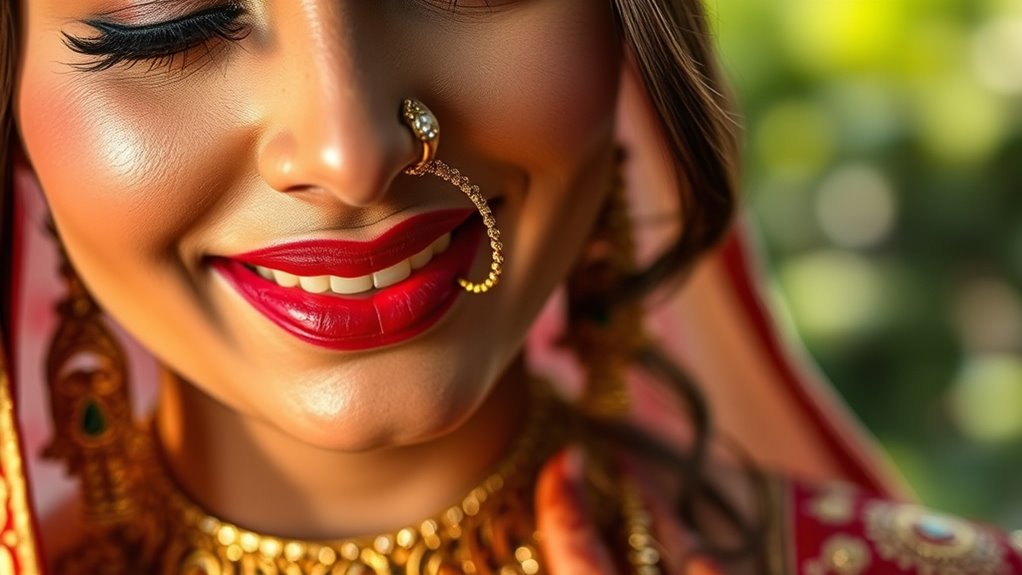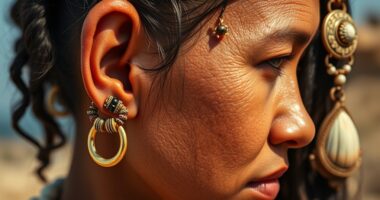Nose rings are a key part of Indian bridal culture, symbolizing beauty, social status, and regional identity. They come in various styles, from large, ornate ‘naths’ in North India to subtle studs in the South. Many believe nose rings also reflect health, fertility, and spiritual well-being. They serve as cultural markers, showing family ties and community belonging. Exploring further reveals how these traditions showcase rich regional craftsmanship and personal expression.
Key Takeaways
- Nose rings symbolize beauty, tradition, and social status in Indian bridal culture, representing cultural identity and marital status.
- Regional variations include different styles, sizes, and materials, reflecting local customs and craftsmanship.
- The placement and design of nose rings convey social messages, community affiliation, and health beliefs.
- Materials like gold and gemstones signify wealth, while simpler designs emphasize minimalism and personal preference.
- Nose rings serve as cultural symbols that express heritage, social values, and regional artistry in Indian bridal adornment.

Nose rings hold a significant place in Indian bridal culture, symbolizing beauty, tradition, and social status. These ornaments are much more than simple jewelry; they embody deep-rooted cultural meanings that vary across regions and communities. The traditional symbolism attached to nose rings often relates to health, prosperity, and spiritual well-being. In Ayurveda, piercing the nose is believed to ease childbirth and menstrual pain, making it a symbol of fertility and well-being. For many, wearing a nose ring is also a mark of a woman’s married status, signifying her *transition* into a new phase of life. The size, style, and placement of the nose ring can communicate social standing or community identity, making it a significant aspect of bridal adornment.
Regional variations play a *pivotal* role in shaping how nose rings are perceived and worn across India. In North India, the nose ring, often called a ‘nath,’ is typically large, ornate, and connected to the hair or ear with a chain. Brides wear a prominent nath during the wedding ceremony, symbolizing respect for tradition and cultural identity. In contrast, South Indian brides tend to wear smaller, more understated nose studs, emphasizing subtle elegance over grandeur. These variations reflect local customs, climate, and aesthetic preferences. For example, in Maharashtra and Gujarat, nose rings are often decorated with intricate designs and gemstones, highlighting the region’s craftsmanship and wealth. Meanwhile, in parts of Northeast India, nose ornaments may resemble tribal jewelry, emphasizing indigenous cultural influences. Additionally, the cultural significance of nose rings can be linked to regional beliefs and practices that reinforce community ties and heritage.
The choice of nose ring and its placement can also vary based on community and personal preference. Some communities wear nose rings on the left nostril, which is believed to be connected to reproductive health, while others opt for the right or both nostrils. The design might incorporate traditional motifs such as floral patterns, paisleys, or religious symbols, further emphasizing regional artistry. The materials used—gold, silver, or even unadorned metal—also differ, with wealthier families favoring elaborate gold pieces and others opting for simpler designs. Regardless of the variation, the nose ring remains a powerful symbol embedded in Indian bridal culture, representing more than adornment; it’s a reflection of identity, heritage, and social values. As a bride, choosing the right nose ring allows you to honor your roots while showcasing your unique cultural expression.
Frequently Asked Questions
What Are the Different Types of Nose Rings Worn in Indian Weddings?
You’ll find various types of nose rings worn in Indian weddings, each with unique symbolism in jewelry and cultural significance. The traditional stud, called a ‘Nath,’ often features intricate designs and is adorned with pearls or gemstones. The ‘Phool’ nose ring symbolizes purity, while the ‘Nath Pali’ connects to marital status. These jewelry pieces reflect cultural traditions, enhance bridal beauty, and symbolize auspiciousness in Indian wedding ceremonies.
How Is the Size of a Bride’s Nose Ring Chosen?
You choose the size of your nose ring based on bridal jewelry selection and nose ring symbolism. Consider your face shape and the traditional significance behind the jewelry, as larger rings often symbolize prosperity and social status. You should try different sizes to see which complements your features best, ensuring the nose ring enhances your overall look while respecting cultural symbolism. This thoughtful selection makes your bridal look more elegant and meaningful.
Are There Specific Rituals Associated With Wearing Nose Rings?
Yes, there are specific rituals associated with wearing nose rings. During traditional ceremonies, you might participate in a ritual where the nose ring symbolizes your marital status and cultural identity. Often, the bride wears it as a sign of auspiciousness and respect for tradition. These ceremonies emphasize the symbolic meanings behind the nose ring, such as invoking blessings and prosperity for your new life.
Do Nose Rings Have Any Specific Health Implications?
You might think nose rings are just beautiful adornments, but they can pose allergy risks or cause infections if not cared for properly. While they look stunning, you should be aware that poor hygiene or allergic reactions to metals like nickel can lead to discomfort or health issues. To prevent infections, keep the piercing clean and choose high-quality, hypoallergenic materials. After all, beauty shouldn’t come at the cost of your health.
How Do Regional Differences Influence Nose Ring Styles?
Regional differences greatly influence nose ring styles, reflecting unique jewelry variations and cultural symbolism. You’ll notice that in North India, large, intricate designs symbolize prosperity, while in Maharashtra, smaller, simpler rings emphasize tradition. South Indian styles often feature gold and temple jewelry influences. These variations showcase local customs, beliefs, and aesthetics, making each nose ring style a meaningful expression of regional identity and cultural heritage, enriching the bridal ensemble with distinct regional charm.
Conclusion
In Indian bridal culture, nose rings are more than just jewelry—they’re a symbol of tradition, beauty, and auspiciousness. As you embrace this timeless accessory, remember that it connects you to centuries of heritage, much like a secret society’s ancient relic. Whether modern or traditional, wearing a nose ring tells your unique story, blending history with the present. So go ahead, celebrate your special day with this beautiful symbol of cultural pride.
















